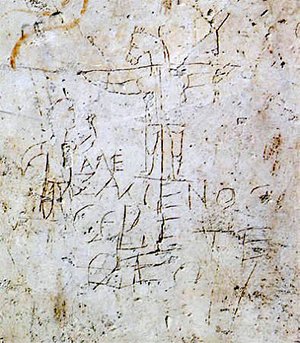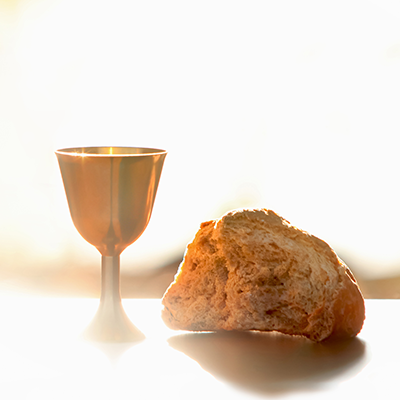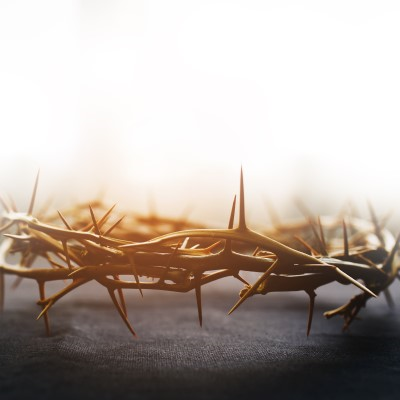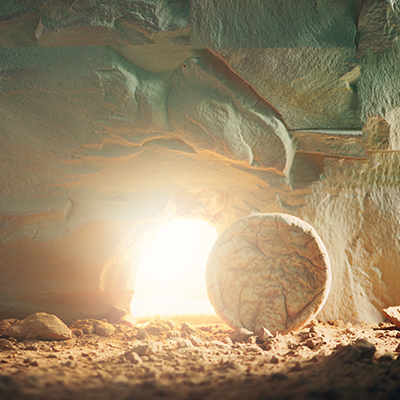Lent Devotional | Good Friday
Trusting in the Silence of Suffering

“Take up your cross and follow me.” – Matthew 16:24, Luke 14:27
 What is thought to be the earliest known image of the crucifixion is in the form of graffiti. The image was discovered in the mid 19th century in Rome in a room on the Palatine Hill that may have housed young pages who served in the imperial court. It’s an unrefined second century sketch scratched on a wall. The crucified figure viewed from behind has the head of a donkey that looks down on a smaller figure beside the cross. The inscription says: “Alexamenos worships his god.” The graffiti is intended to mock the Christian worship of a crucified deity that would have been deemed ridiculous by the pagan polytheists in Rome.
What is thought to be the earliest known image of the crucifixion is in the form of graffiti. The image was discovered in the mid 19th century in Rome in a room on the Palatine Hill that may have housed young pages who served in the imperial court. It’s an unrefined second century sketch scratched on a wall. The crucified figure viewed from behind has the head of a donkey that looks down on a smaller figure beside the cross. The inscription says: “Alexamenos worships his god.” The graffiti is intended to mock the Christian worship of a crucified deity that would have been deemed ridiculous by the pagan polytheists in Rome.
The very idea of a crucified Messiah draws scorn. How is it one could find the source of redemption in a figure who was subjected to torture and humiliating public execution underwritten by the powers of state? Surely this is a narrative of weakness and failure. Death by crucifixion was reserved for the lowest of the low, the dregs of society. It was the most degrading and dehumanizing form of punishment. Who would wish to place their hopes and longings for deliverance and salvation in a bent and bleeding figure hanging on a gibbet?
Paul spoke of the “scandal of the cross” an offence and a socially unacceptable image. And yet he affirms that “Christ crucified” is the very foundation of our Christian faith. Good Friday tells a story of ridicule and rejection of weakness and suffering. The cross is a stark reminder of our own condition of powerlessness and inability to solve the condition of human brokenness. In a surprising twist, faithful discipleship takes on the form of this shameful instrument of death and becomes the pattern for life. “Take up your cross and follow me.”
There is an ever-present temptation to turn away from the ugly reality of crucifixion and embrace a narrative of clean triumph. But the gospels are clear, the route to resurrection is by way of crucifixion. These two should not be separated either in the narrative or in our lives.

John Franklin
Executive Director, Imago
Prayer
Lord, release us from the draw to self-centredness and free us to practice self-giving love. Restrain us from moving too quickly to the comforts of triumph and grant us the resolve to walk the way of the cross in the company of our Redeemer – in whose name I pray.
Reflection
We have been invited to take up our cross and follow Jesus. Consider what this might mean for you. In a culture where self-interest is a dominating theme, we do well to consider afresh what the cross teaches us about the life of faith.
“Take up your cross and follow me.” – Matthew 16:24, Luke 14:27
What is thought to be the earliest known image of the crucifixion is in the form of graffiti. The image was discovered in the mid 19th century in Rome in a room on the Palatine Hill that may have housed young pages who served in the imperial court. It’s an unrefined second century sketch scratched on a wall. The crucified figure viewed from behind has the head of a donkey that looks down on a smaller figure beside the cross. The inscription says: “Alexamenos worships his god.” The graffiti is intended to mock the Christian worship of a crucified deity that would have been deemed ridiculous by the pagan polytheists in Rome.
The very idea of a crucified Messiah draws scorn. How is it one could find the source of redemption in a figure who was subjected to torture and humiliating public execution underwritten by the powers of state? Surely this is a narrative of weakness and failure. Death by crucifixion was reserved for the lowest of the low, the dregs of society. It was the most degrading and dehumanizing form of punishment. Who would wish to place their hopes and longings for deliverance and salvation in a bent and bleeding figure hanging on a gibbet?
Paul spoke of the “scandal of the cross” an offence and a socially unacceptable image. And yet he affirms that “Christ crucified” is the very foundation of our Christian faith. Good Friday tells a story of ridicule and rejection of weakness and suffering. The cross is a stark reminder of our own condition of powerlessness and inability to solve the condition of human brokenness. In a surprising twist, faithful discipleship takes on the form of this shameful instrument of death and becomes the pattern for life. “Take up your cross and follow me.”
There is an ever-present temptation to turn away from the ugly reality of crucifixion and embrace a narrative of clean triumph. But the gospels are clear, the route to resurrection is by way of crucifixion. These two should not be separated either in the narrative or in our lives.

What is thought to be the earliest known image of the crucifixion is in the form of graffiti. The image was discovered in the mid 19th century in Rome in a room on the Palatine Hill that may have housed young pages who served in the imperial court. It’s an unrefined second century sketch scratched on a wall. The crucified figure viewed from behind has the head of a donkey that looks down on a smaller figure beside the cross. The inscription says: “Alexamenos worships his god.” The graffiti is intended to mock the Christian worship of a crucified deity that would have been deemed ridiculous by the pagan polytheists in Rome.
The very idea of a crucified Messiah draws scorn. How is it one could find the source of redemption in a figure who was subjected to torture and humiliating public execution underwritten by the powers of state? Surely this is a narrative of weakness and failure. Death by crucifixion was reserved for the lowest of the low, the dregs of society. It was the most degrading and dehumanizing form of punishment. Who would wish to place their hopes and longings for deliverance and salvation in a bent and bleeding figure hanging on a gibbet?
Paul spoke of the “scandal of the cross” an offence and a socially unacceptable image. And yet he affirms that “Christ crucified” is the very foundation of our Christian faith. Good Friday tells a story of ridicule and rejection of weakness and suffering. The cross is a stark reminder of our own condition of powerlessness and inability to solve the condition of human brokenness. In a surprising twist, faithful discipleship takes on the form of this shameful instrument of death and becomes the pattern for life. “Take up your cross and follow me.”
There is an ever-present temptation to turn away from the ugly reality of crucifixion and embrace a narrative of clean triumph. But the gospels are clear, the route to resurrection is by way of crucifixion. These two should not be separated either in the narrative or in our lives.

John Franklin
Executive Director, Imago
Prayer
Lord, release us from the draw to self-centredness and free us to practice self-giving love. Restrain us from moving too quickly to the comforts of triumph and grant us the resolve to walk the way of the cross in the company of our Redeemer – in whose name I pray.
Reflection
We have been invited to take up our cross and follow Jesus and it is often affirmed that the Christian life is cruciform. Consider what this might mean for you and the faith community of which you are a part. In a culture where self-interest is a dominating theme, we do well to consider afresh what the cross teaches us about the life of faith.
Read the devotions

Palm Sunday
April 13

Maundy Thursday
April 17

Good Friday
April 18

Easter Sunday
April 20